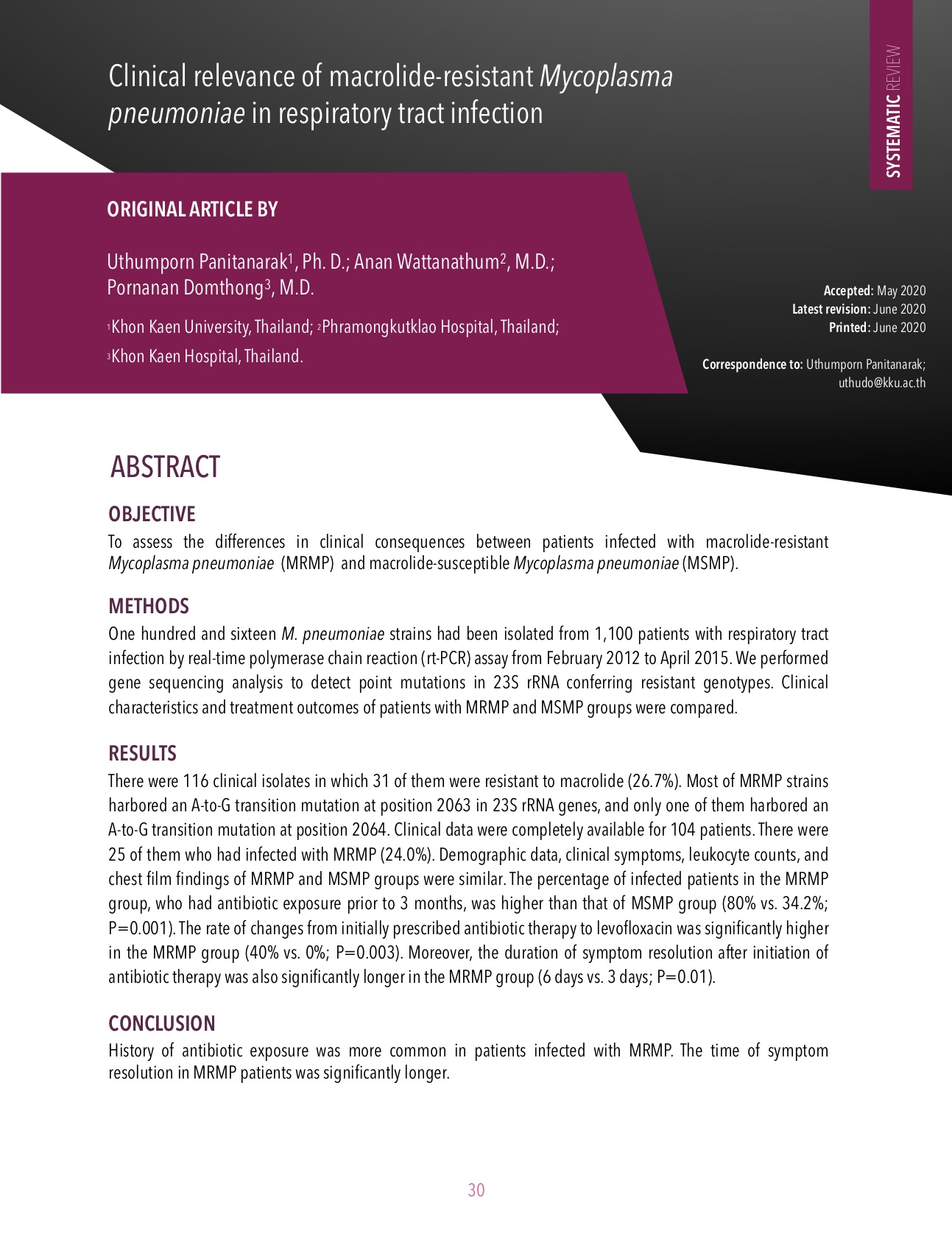Clinical relevance of macrolide-resistant Mycoplasma pneumoniae in respiratory tract infection
Keywords:
Mycoplasma pneumoniae, Macrolide-resistant, Respiratory tract infection, Gene mutationAbstract
OBJECTIVE
To assess the differences in clinical consequences between patients infected with macrolide-resistant Mycoplasma pneumoniae (MRMP) and macrolide-susceptible Mycoplasma pneumoniae (MSMP).
METHODS
One hundred and sixteen M. pneumoniae strains had been isolated from 1,100 patients with respiratory tract infection by real-time polymerase chain reaction (rt-PCR) assay from February 2012 to April 2015. We performed gene sequencing analysis to detect point mutations in 23S rRNA conferring resistant genotypes. Clinical characteristics and treatment outcomes of patients with MRMP and MSMP groups were compared.
RESULTS
There were 116 clinical isolates in which 31 of them were resistant to macrolide (26.7%). Most of MRMP strains harbored an A-to-G transition mutation at position 2063 in 23S rRNA genes, and only one of them harbored an A-to-G transition mutation at position 2064. Clinical data were completely available for 104 patients. There were 25 of them who had infected with MRMP (24.0%). Demographic data, clinical symptoms, leukocyte counts, and chest film findings of MRMP and MSMP groups were similar. The percentage of infected patients in the MRMP group, who had antibiotic exposure prior to 3 months, was higher than that of MSMP group (80% vs. 34.2%; P=0.001). The rate of changes from initially prescribed antibiotic therapy to levofloxacin was significantly higher in the MRMP group (40% vs. 0%; P=0.003). Moreover, the duration of symptom resolution after initiation of antibiotic therapy was also significantly longer in the MRMP group (6 days vs. 3 days; P=0.01).
CONCLUSION
History of antibiotic exposure was more common in patients infected with MRMP. The time of symptom resolution in MRMP patients was significantly longer.
References
Wattanathum A, Chaoprasong C, et al. Community acquired pneumonia in Southeast Asia: The microbial differences between ambulatory and hospitalized patients. CHEST 2003; 123:1512-9.
Dumke R, Von Baum H, Lu¨ck PC, Jacobs E. Occurrence of macrolide resistant Mycoplasma pneumoniae strains in Germany.ClinMicrobiol Infect 2009; 16:613–6.
Peuchant O,Ménard A,Renaudin H,Morozumi M, Ubukata K, Bébéar CM,Pereyre S. Increased macrolide resistance of Mycoplasma pneumoniae in France directly detected in clinical specimens by real-time PCR and melting curve analysis. J. Antimicrob. Chemother. 2009; 64 (1): 52-58.
Averbuch D, Hidalgo-Grass C, Moses AE, Engelhard D, and Nir Paz R. Macrolide resistance in Mycoplasma pneumonia, Israel, 2010. Emerging Infectious diseases 2011; 17:1079-82.
Yamada M, Buller R, Bledsoe S, Storch GA. Rising rates of macrolide-resistant Mycoplasma pneumoniae in the central United States. Pediatr Infect Dis J. 2012; 31(4):409-0.
Suzuki S, Yamazaki T,Narita M, Okazaki N, Suzuki I, TomoakiAndoh I, et al. Clinical Evaluation of Macrolide-Resistant Mycoplasma pneumonia. Antimicrob.Agents Chemother 2006; 50: 2: 709-712.
Miyashita N, Kawai Y, et al. Macrolide-resistant Mycoplasma pneumonia in adolescents with community-acquired pneumonia. BMC infectious diseases 2012; 12:126-42.
Hong KB, Choi EH, Lee HJ, et al. Macrolide resistance of Mycoplasma pneumonia, South Korea, 2000-2011. Emerg Infect Dis 2013; 19:1281-84.
Cho B, Zhao C, Yin YD, et al. High prevalence of Mycoplasma pneumonia Isolates from adult and adolescent patients with respiratory tract infection in China.CID 2010 ;51:189-94.
Eliakim-Raz N, Robenshtok E, Shefet D, et al. Empiric antibiotic coverage of atypical pathogens for community-acquired pneumonia in hospitalized adults. Cochrane Database Syst Rev 2012;9:CD004418-CD004418.
Wolff BJ, Thacker WL, Schwartz SB, and Winchell JM. Detection of Macrolide Resistance in Mycoplasma pneumoniae by Real-Time PCR and High-Resolution Melt Analysis. Antimicrobial Agents and Chemotherapy 2008;3542–3549.
Liu Y, Ye X, Zhang H, Xu X, Li W, Zhu D, Wang M. Antimicrobial Susceptibility of Mycoplasma pneumoniae Isolates and Molecular Analysis of Macrolide-Resistant Strains from Shanghai, China. Antimicrob.Agents Chemother 2009; 53(5):2160-2162.
Yooa SJ, Kimb HB, Choi SH, et al. Differences in the Frequency of 23S rRNA Gene Mutations in Mycoplasma pneumoniae between Children and Adults with Community-Acquired Pneumonia: Clinical Impact of Mutations Conferring Macrolide Resistance. Antimicrob.Agents Chemother 2012;56: (12) 6393-6396.
Principi N, Esposito S. Macrolide-resistant Mycoplasma pneumoniae: its role in respiratory infection. J. Antimicrob. Chemother. 2013; 68 (3): 506-511.



